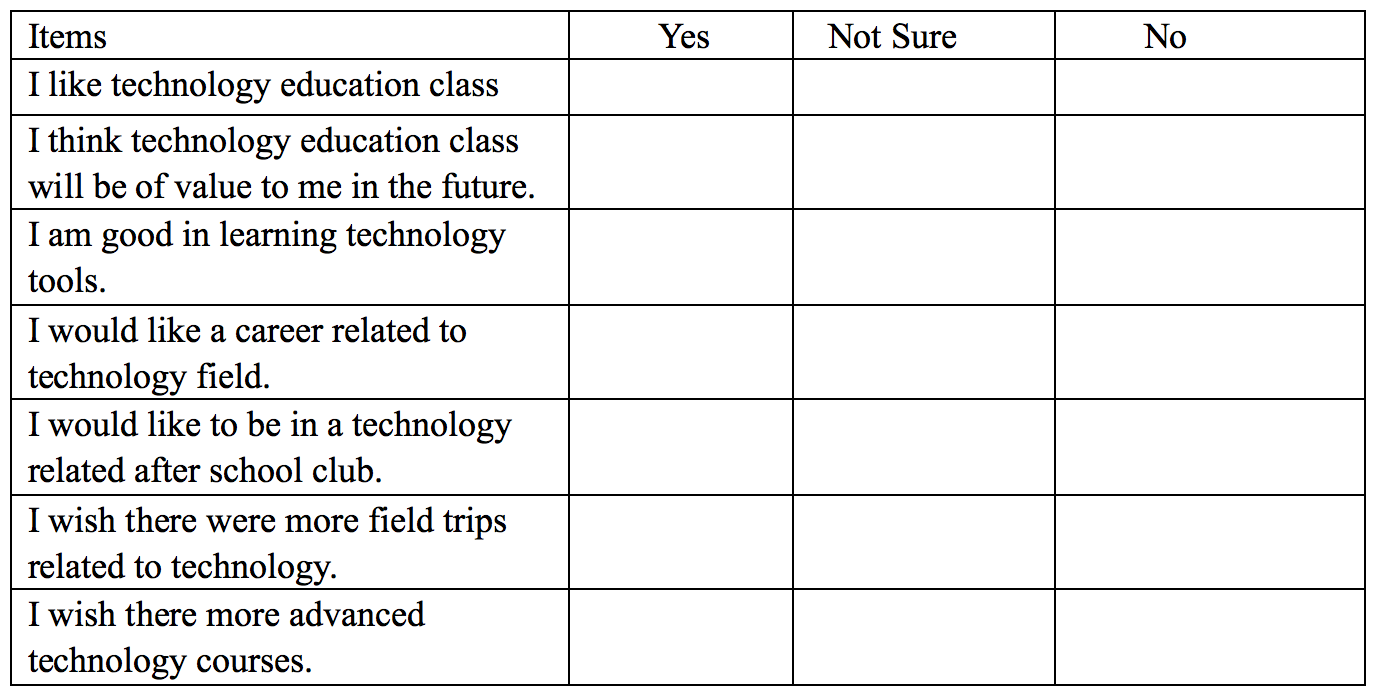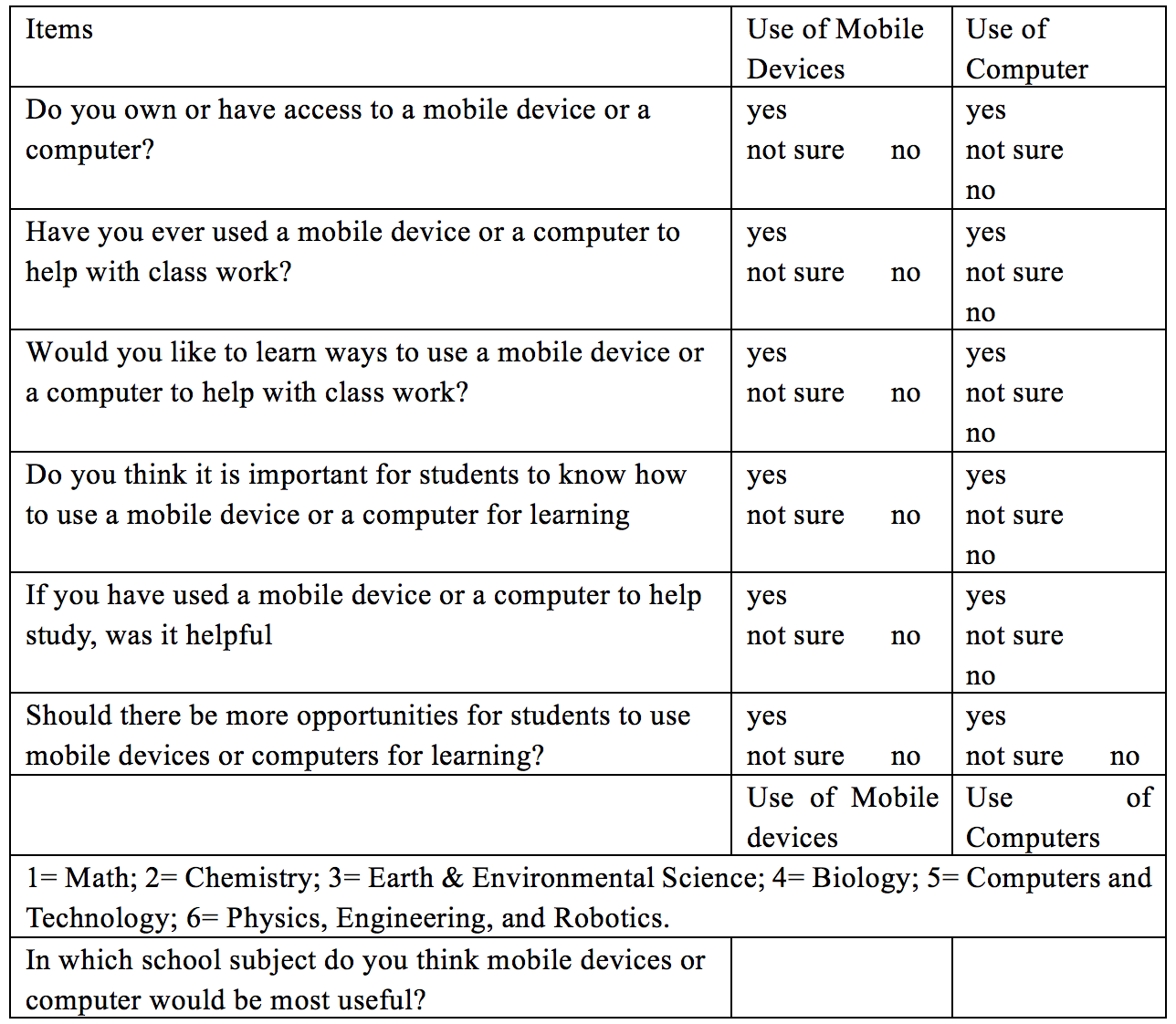Utilizing Technology for Learning STEM Subjects: Perceptions of Urban African-American Middle School Students
By
2016, Vol. 8 No. 02 | pg. 1/3 | » AbstractThis study was designed to explore current issues of access, interests and attitudes towards technology use in STEM related courses for a population of middle school students enrolled at a Title I urban school in the South. The participants in the study were largely African-American students enrolled in grades 6, 7 and 8. Data were collected from 124 usable anonymous surveys. The study focused on respondents’ perceptions of and experiences with computers and mobile devices, especially with respect to learning in math, science, technology and other so-called STEM courses. Potential differences among grade levels and genders were also examined by a series of non-parametric tests. The results of this study indicated African-American students at this school held positive views of technology and its potential in their education. They showed great interests regarding how to use technology for learning and they preferred using mobile devices in mathematics. Few differences were noted by gender and grade levels. Implications for integrating technology into STEM education at the middle level are offered. The use of educational technology in K-12 classrooms has steadily increased over the last few decades (Cheung & Salvin, 2013). Evidence shows that educational technology has either transformed or facilitated the transformation of instruction to a more student-centered paradigm (Clark-Wilson, Hoyles, Noss, Vahey & Roschelle, 2015; Sessoms, 2008; Oravetz, 2011). In the modern classroom, filled with “digital natives,” technology provides multiple paths to content, facilitates peer-to-peer and student-to-teacher interactions, and functions as interactive tutors, to name a few applications (Grant & Barbour, 2013). Modern digital technology appears well positioned to play an increasingly central role in education in the future, with perhaps online and mobile applications leading the way (Eschenbrenner & Nah, 2007; Project Tomorrow, 2013). Although the evidence on the impact of technology on learning has been mixed, clear evidence is present that technology can improve access and have a positive impact on interest, especially in the sciences (Hmelo-Silver, Eberbach & Jordan, 2014). Students, for example, are much more likely to be engaged in learning when interacting with a multimedia, game-based simulation than simply reading a chapter in a textbook (Grant & Barbour, 2013).A contemporary issue with regard to educational technology is to find ways to realize its potential to impact learning and interests in science, computing, engineering, mathematics and other so-called technical disciplines (STEM). It is especially true for populations of students who are traditionally under-represented in these disciplines and for whom many researchers believe technology can play a pivotal role in closing participation and performance gaps (Fairlie, 2012; Mouza, 2008). This is significant because it is well documented that the rate at which the United States produces STEM professionals is not in keeping pace with that of other industrialized nations (Hossain&Robinson, 2012). Additionally, as the demographics of the United States change, increasing interests and readiness for STEM careers among women, African American and other groups has become a national priority (Farinda & Lewis, 2012). With rising expectations for the potential of technology to help address issues of under-representation of certain groups in the STEM disciplines (Taines, Schneider & Blumenfeld, 2000), researchers have a renewed interest in issues of access and attitudes (Fairlie, 2012; McHale, 2007). Technology obviously cannot reach its potential utility if students and teachers lack access or possess attitudes that inhibit its utilization (Fairlie, 2012; McNierney, 2004; McHale, 2007). For example, MacHale (2007) indicated that the challenge of technology implementation in schools is most acute in serving low-socioeconomic, African-American students. This challenge has its origins in the level of access these students have to the technology itself, and specifically their access to applications related to learning. Low income students are less likely than their peers to have utilized technology on a regular basis for learning in school or outside of school (Fairlie, 2012). This has implications for their ability to benefit from technology-based in-school learning experiences as well as their attitudes towards its role in learning. Our study explores issues of access, interests and attitudes towards technology use in STEM-related courses for a population of middle school students enrolled at a Title I urban school. The students included in the study are largely African-American students from low socio-economic status (SES). The study reveals their perceptions of and experiences with computers and mobile devices, especially with respect to learning. This descriptive study also addresses potential differences among grade levels and genders. The results of this study are significant as educators attempt to design instructional environments that maximize the potential of technology for this population and these content areas. Literature ReviewTechnology AccessAccess is an issue with regard to technology in K-12 education, particularly for low-income and minority youth (Fairlie, 2012; McHale, 2007). Although in the United States the hundreds of millions of dollars have been invested in hardware and software (Cheung & Salvin, 2011), the technology gap persists when measured by the pedagogical practices associated with technology use in different schools. Fairlie (2012) reveals that the disparities in access to technology are partly responsible for the achievement gap between minority students and non-minority students. When it comes to the question of availability of equipment and the successful technology integration into the classroom, a concern is present that not all students, particularly students in schools with a high percentage of minority or poor students, had equal access to educational technology (Department of Education, 2003; Hesseldahl, 2008; Ritzhaupt, Liu, Dawson & Barron, 2013). In Louisiana, 27 percent of school-aged children are in poverty, or 212,904 potential students (Lane, 2014). The state has the fourth highest rate of school-aged children living in poverty among the 50 United States and Washington, D.C., according to 2013 data from the U.S. Census Bureau (Lane, 2014). Lower socioeconomic families generally have less access to Information and Communication Technology (ICT) in their homes (e.g., computers and broadband Internet connections) (Hesseldahl, 2008; Ritzhaupt, Liu, Dawson & Barron, 2013) and less likely to have the necessary skills and knowledge to meaningfully use these resources (Hesseldahl, 2008). Other the other hand, few research has also shown that over the years the number of US African-American students with access to technology devices has improved (Fairlie, 2012; McHale, 2007). Researchers and educators attempt to understand the impact that it has on African-American students (Fairlie, 2012; McHale, 2007). African-American students who use computers to solve homework problems achieve better educational outcomes than those who do not (Fairlie, 2012). In McHale’s 2007 report, the Irving Independent School District of Texas supported technology integration through extensive hardware resources. With more than 31,000 students, most of whom were African American and economically disadvantaged, all high school students had laptops for school and home use; teachers were required to be trained with extensive online resources, such as streaming video through Discovery’s unitedstreaming and DigitalCurriculum.com and e-learning portals through Blackboard. The goal of the Ivring school district was to call for every student to be issued a personal computing device and for technology use to be comprehensive and transparent. It seems that technology rich classrooms and wireless laptops for every student in the United States is not a lofty goal. Therefore, the researchers were motivated to look at African-American students’ accessibility to computer and mobile devices for learning purpose in and out of school in the East Baton Rouge Parish of Louisiana. Gender Difference in the Use of TechnologyIn 2004, Goldstein and Puntambekar conducted a mixed methods study of middle school students’ attitudes towards using computers and working in groups during scientific inquiry. The goal of their study was to explore the role of gender in learning from computers. A sample of 160 students from a suburban middle school in Connecticut participated in the CoMpass project, a hypertext online tool designed to help students gain a deeper understanding of relationships among science concepts. The results showed no significant gender differences in a pre-test measure of computer attitude, but significant differences in post-test scores. Boys had higher scores on the importance of computers and showed a greater preference for learning from computers than girls. On the other hand, a study of race and gender and their relationship to Information and Communication Technology (ICT) reveals wide gaps, particularly when looking at Caucasian versus African-American children (Jackson, Zhao, Kolenic, Fitzgerald, Harold, & Von-Eye, 2008). Interestingly, this study reveals that African-American males were less likely to meaningfully use ICT resources when compared to their African-American females counterparts as well as both male and female Caucasians. In addition, females appear to be more proficient ICT users compared to their male counterparts (Ritzhaupt, Liu, Dawson & Barron, 2013). This and other studies have helped shed light on gender differences in terms of instructional technology (e.g., Jackson et al., 2008; KAHVECI, 2010; Plumm, 2006; Ritzhaupt et al., 2013). However, there has been little research on gender differences among minority middle school students in their preferences for technology-based learning, particularly in the STEM disciplines (Else-Quest, Mineo, Higgins, 2013). Some evidences reveal, however, that the dynamics of gender and education may operate differently in some minority groups, with female participation rates being higher than that of males (Griffith, 2010; Ong, 2011). This possibility was investigated in this study with regard to attitudes and preferences for STEM related technology-based learning. MethodologyThis study employed a survey methodology. The survey responses from African-American students provided scalable data to address the following research questions:
Research Context and ParticipantsIn order to answer the research questions, researchers purposefully selected a Title I, urban middle school in south central Louisiana, a charter school using Louisiana Comprehensive Curriculum with supported electives. In 2012, this school enrolled 479 students came from various ethnic backgrounds. Most of the students were African American, 413 of 479 (86%), the rest were distributed as follows: 17 Caucasian (3.6%), 19 Hispanics (4.1%), 6 Asians (1.3%), 1 American Indian (0.2%), 1 Pacific Island (0.2%), and 22 designated as mixed race (two or more races) (4.6%). 94% of the 479 students here are paying reduced lunch prices. Most of the students come from low-income families. This school has been operated by the Pelican Education Foundation in Baton Rouge since 2009. Pelican Educational Foundation is a local community based non-profit organization established in December 2005 that is dedicated to preparing students for academic success through enhanced learning of math, science and technology. This new concept for education was developed through a workgroup comprised of professors from Louisiana State University, Southern University, and Southeastern Louisiana University. This school holds the school-wide science fair (STEM Expo) annually beginning from 2008. This study took place at the 2012 STEM Expo. The purpose of the Expo is to expose Louisiana’s to the exciting and engaging world of science, technology, engineering and mathematics (STEM) and to ignite their interests and motivation for these disciplines (“Louisiana STEM Expo,” 2014). Participating students worked with their teachers and/or mentors to prepare a demo that they presented to the public at the Expo. Presenters were judged by volunteers from local universities and industries and winners were given prizes (e.g., IPods). Typically, this school provides equal opportunity for all students to learn advanced science, mathematics and technology curriculum; to prepare all our students to high school with strong background on all areas; to increase performance on state tests and to increase literacy and numeracy of all our students above their grade level. The paper survey was then sent out to all the middle school students after the 2012 STEM Expo. The return rate was approximately 31.3%, 150 out of 479. It is rather low. Possible reason was that the survey was conducted only one time so that most of the students might not have time to complete it since they focused on their science presentations. Among those returned surveys, 124 surveys were completed by African-American students. InstrumentationThis study utilized a modified instrument from Mahoney’s instrument for high school STEM-Based Programs (2009). This instrument was established to indicate students’ attitudes toward STEM, so that educational institutions that are implementing a STEM-based program can ascertain if their program is having the desired influence on their students. According to Mahoney (2009), the statistical analyses applied to the instrument items provided strong indications of reliability, Cronbach’s alpha scores were all above coefficient of .92 (p.32). Cronbach’s alpha reliability coefficient normally ranges between 0 and 1. The following rules of thumb are:“.9 is Excellent, . 8 is Good,.7 is Acceptable, .6 is Questionable, .5 is Poor, and .5 is Unacceptable” (George and Mallery, 2003, p. 231). The researchers designed the survey regarding technology education and the use of technology for STEM learning based on Mahoney’s instrument, it consists of three sections: demographics; interests in technology education; and the use of technology for learning. The section of interests in technology education consists of seven items (see Appendix A). The responses were recorded to reflect—1 (no). 2 (not sure), 3 (yes). According to reliability analysis in SPSS, Cronbach's alpha is: 0.831 (relatively good) (table 1). The section of the use of technology for learning consists of seven items (see Appendix A). The responses of the first six items were recorded to reflect—1 (no), 2 (not sure), 3 (yes). According to reliability analysis, Cronbach’s alpha are .792 and .782(acceptable) (table 1). ProceduresIn order to efficiently survey students, the teachers and administrators at the school were recruited to encourage participation. Students were given a packet with the survey instrument, consent forms and instructions for returning the instruments. Followed by IRB procedure, parents signed the parental permission form if they agreed to allow their children to complete the survey. To minimize disruption at the school, the survey was administered in only one wave. Participants were given a week to return the completed survey. Data AnalysisDescriptive statistics were used to characterize the responses of respondents to the survey. An assessment of the normality of data is a prerequisite for many statistical tests because normal data is an underlying assumption in parametric testing. The Shapiro-Wilk Test is more appropriate for small sample sizes (Royston, 1982), for this reason, in this study, the researcher used the Shapiro-Wilk test as the numerical means of assessing normality. In the section of interests in technology education, the results of the Shapiro Wilk test indicated that the data is not normally distributed, p = .000 (Table 2). In the section of the use of technology for learning, either of the two variables is not normally distributed, mobile devices use for learning, p = .000; computer use for learning, p = .000, according to their Shapiro Wilk tests (Table 2). Since the assumption of normality is violated, the researchers chose to use non-parametric tests to answer the research questions. In this study, a Mann-Whitney U test is used to compare differences between two independent groups (African-American boys and African-American girls) when the dependent variable is either ordinal or continuous, but not normally distributed. The Mann-Whitney test relies on scores being ranked from lowest to highest; therefore, the group with the lowest mean rank is the group with the greatest number of lower scores in it. Similarly, the group with the highest mean rank should have greater number of high scores within it. A Kruskal-Wallis H test was used to analyze whether the total score were differed significantly among grade levels. The Kruskal-Wallis H test is a rank-based nonparametric test that can be used to determine if there are statistically significant differences between two or more groups of an independent variable on a continuous or ordinal dependent variable. It is considered the nonparametric alternative to the one-way ANOVA, and an extension of the Mann-Whitney U test to allow the comparison of more than two independent groups (Gibbons, 1993, p.31-44). Suggested Reading from Inquiries Journal
Inquiries Journal provides undergraduate and graduate students around the world a platform for the wide dissemination of academic work over a range of core disciplines. Representing the work of students from hundreds of institutions around the globe, Inquiries Journal's large database of academic articles is completely free. Learn more | Blog | Submit Latest in Education |






















